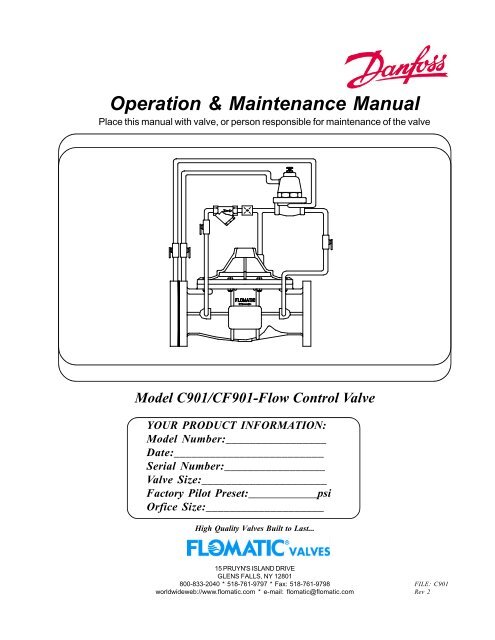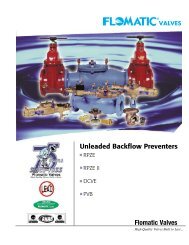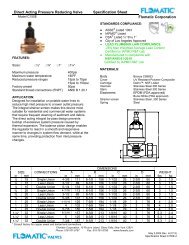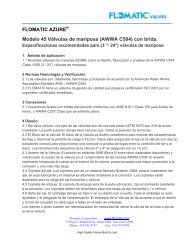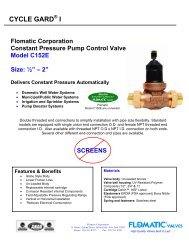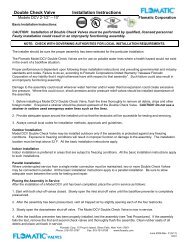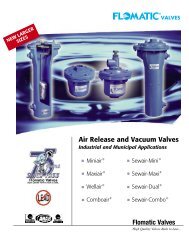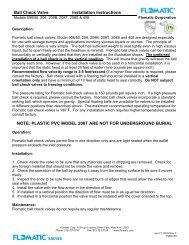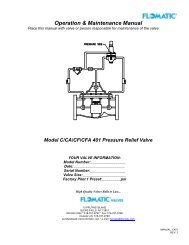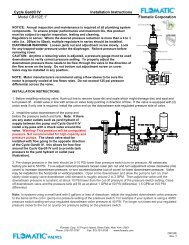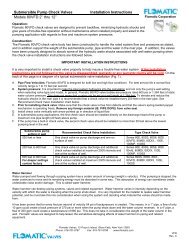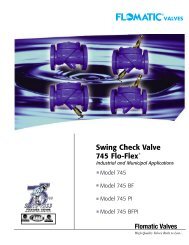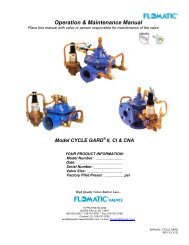Model C901/CF901-Flow Control Valve
Model C901/CF901-Flow Control Valve
Model C901/CF901-Flow Control Valve
Create successful ePaper yourself
Turn your PDF publications into a flip-book with our unique Google optimized e-Paper software.
Operation & Maintenance ManualPlace this manual with valve, or person responsible for maintenance of the valve<strong>Model</strong> <strong>C901</strong>/<strong>CF901</strong>-<strong>Flow</strong> <strong>Control</strong> <strong>Valve</strong>YOUR PRODUCT INFORMATION:<strong>Model</strong> Number:_________________Date:_________________________Serial Number:_________________<strong>Valve</strong> Size:_____________________Factory Pilot Preset:____________psiOrfice Size:____________________High Quality <strong>Valve</strong>s Built to Last...15 PRUYN'S ISLAND DRIVEGLENS FALLS, NY 12801800-833-2040 * 518-761-9797 * Fax: 518-761-9798worldwideweb://www.flomatic.com * e-mail: flomatic@flomatic.comFILE: <strong>C901</strong>Rev 2
Information needed to order replacement parts:<strong>Valve</strong> Size ________________Serial # ________________<strong>Model</strong> # <strong>C901</strong>Main <strong>Valve</strong>Open PositionExterior <strong>Valve</strong> Components1Shut-Off <strong>Valve</strong>3OrificeAdjustment Screw6Finger Strainer2Strainer3Needle <strong>Valve</strong>4Pilot <strong>Valve</strong>5Orifice Plate
TROUBLE SHOOTING GUIDEA. PROBLEM : <strong>Valve</strong> opens and will not close resulting in excessive outlet pressure.CAUSE1. Main valve is air bound.2. Shut-off (isolation) valve at the outlet side of control isclosed.3. Indicator stuffing box or sight glass is leaking.4. Ruptured diaphragm in pilot valve. (Evidenced by leakfrom vent hole in spring chamber.)5. Fouled orifice or needle valve.6. Fouled strainer.7. Damaged pilot valve seat.8. Ruptured diaphragm in main valve.9. Sticks or stones lodged under seat of main valve.10. Worn seat packing and/or seat ring in main valve.11. Incorrect adjustment of pilot valve (set too high).12. Leakage from one or more fittings in the controls.13. Damaged O-ring stem seal.B. PROBLEM: <strong>Valve</strong> is closed and will not open.1. Incorrect adjustment of pilot valve. (Set too low)2. Needle valve (if installed) open too far.3. Shut off (isolation) valve at the outlet side of the controlsis closed.4. Fouled pilot valve5. Worn or eroded orifice (or needle valve seat).CORRECTION1. Open 1/8" air bleeder at the top of valve to release air.2. Open shut-off valve.3. Tighten packing nut or replace packing seals.4. Replace diaphragm.5. Open needle valve wide (counter clockwise) to flush seat,& after 4 or 5 seconds return to original setting, or removeand clean orifice.6. Disassemble, clean or replace screen.7. Disassemble, clean and replace damaged parts.8. Disassemble and replace diaphragm.9. Disassemble and remove. Replace damaged parts.10. Disassemble and replace damaged parts.11. For back pressure valve turn adjusting screw counterclockwise slowly until valve resumes control and the desiredoutlet pressure is obtained.12. Tighten or replace fitting.13. Disassemble and replace O-ring.1. Turn pilot valve adjusting screw clockwise slowly untilthe valve opens and the desired outlet pressure is obtained.2. Turn adjusting cap clockwise slowly until valve opensand a reduced outlet pressure is observed. Lock in thisposition.3. Open shut-off (isolation) valve.4. Disassemble and clean, replace seat ring/packing is necessary.5. Replace orifice (or needle valve).C. PROBLEM: <strong>Valve</strong> hunts or chatters (evidenced by rapidly changing outlet pressure).1. <strong>Valve</strong> is oversized.2. <strong>Flow</strong> control valve (or needle-valve at the outlet side ofcontrols) is out of adjustment.3. Pilot valve seat packing is damaged.1. Install a smaller pressure reducing valve in a bypassaround the oversized valve to handle low flows and providebetter control.2. Slowly turn adjusting cap counter clockwise until theoutlet pressure becomes steady.3. Replace seat packing.Test To Isolate Source Of Problem(After visual inspection of external leaks)1. With the main line gate valves open and the reducing valve pressurized, close the control shut-off (isolation) valveat the outlet side of the pressure reducing pilot control. THE MAIN VALVE SHOULD CLOSE.If the valve remains fully open the source of the problem could be:(A) fouled orifice or needle; (B) fouled strainer; (C) control shut off valve at inlet is closed; (D) ruptured main valve diaphragm.If the valve is partially closed the source of the problem could be:(A) damaged: main valve seat packing or seat ring; (B) debris under seat; (C) main valve is air-bound; (D) damaged stem O-ring.If the valve closes fully, the source of the problem could be:(A) pilot valve out of adjustment; (B) damaged pilot valve stem or set ring; (C) partially fouled strainer or needle valve.2. With the main line gate valves open and the reducing valve pressurized, close both shut-off (isolation) valves andopen the air bleeder pet cock to release water out of the power chamber above the diaphragm of the reducing valve.Water will flow from the pet cock as the valve moves to the full open position.If water continues to flow, the source of the problem could be:(A) damaged: main valve diaphragm or stem seal O-ring; (B) loose locknut.


